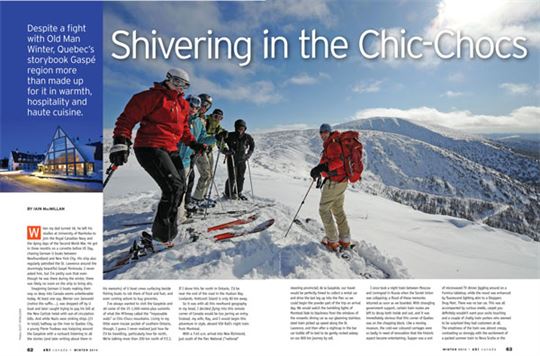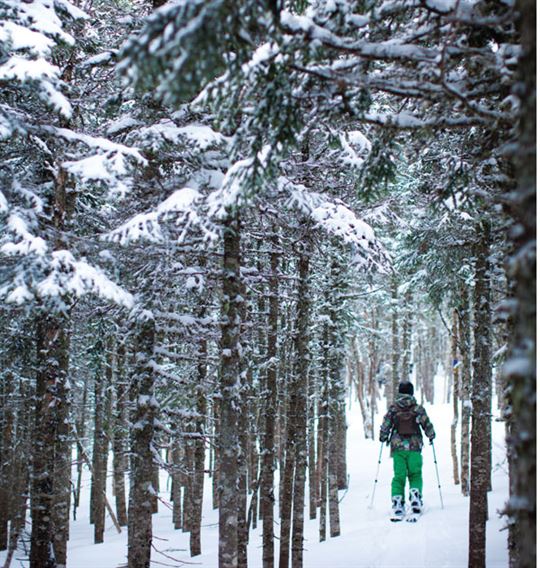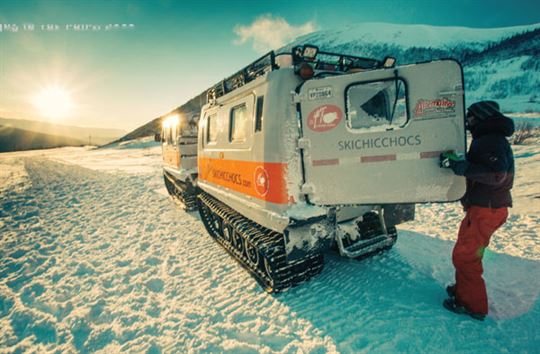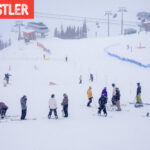Despite a fight with Old Man Winter, Quebec’s storybook Gaspé region more than made up for it in warmth, hospitality and haute cuisine.
By Iain MacMillan in the Winter 2014 issue

When my dad turned 18, he left his studies at University of Manitoba to join the Royal Canadian Navy and the dying days of the Second World War. He got in three months on a corvette before VE Day, chasing German U boats between Newfoundland and New York City. His ship also regularly patrolled the St. Lawrence around the stunningly beautiful Gaspé Peninsula. I never asked him, but I’m pretty sure that even though he was there during the winter, there was likely no room on the ship to bring skis.
Imagining German U boats making their way so deep into Canada seems unbelievable today. At least one spy, Werner von Janowski (notice the suffix…), was dropped off by U boat and later caught trying to pay his bill at the New Carlisle hotel with out-of-circulation bills. And while Nazis were sinking ships (23 in total) halfway up the river to Quebec City, a young Pierre Trudeau was traipsing around the Gaspésie with a rucksack listening to all the stories (and later writing about them in his memoirs) of U boat crews surfacing beside fishing boats to rob them of food and fuel, and even coming ashore to buy groceries.
I’ve always wanted to visit the Gaspésie and ski some of the 25 1,000-metre-plus summits of what the Mi’kmaq called the “impassable walls” or Chic-Chocs mountains. Living in my little warm insular pocket of southern Ontario, though, I guess I never realized just how far I’d be travelling, particularly how far north. We’re talking more than 200 km north of P.E.I. If I drove this far north in Ontario, I’d be near the end of the road in the Hudson Bay Lowlands. Anticosti Island is only 80 km away.
So it was with all this newfound geography in my head, I decided flying into this remote corner of Canada would be too jarring an entry. Instead, my wife, Ray, and I would begin this adventure in style, aboard VIA Rail’s night train from Montreal.
With a 7:45 a.m. arrival into New Richmond, just south of the Parc National (“national” meaning provincial) de la Gaspésie, our travel would be perfectly timed to collect a rental car and drive the last leg up into the Parc so we could begin the powder part of the trip on arrival day. We would watch the twinkling lights of Montreal fade to blackness from the windows of the romantic dining car as our gleaming stainless steel train picked up speed along the St. Lawrence, and then after a nightcap in the bar car toddle off to bed to be gently rocked asleep on our 800 km journey by rail.
I once took a night train between Moscow and Leningrad in Russia when the Soviet Union was collapsing; a flood of these memories returned as soon as we boarded.
I once took a night train between Moscow and Leningrad in Russia when the Soviet Union was collapsing; a flood of these memories returned as soon as we boarded. With strangling government support, certain train routes are left to decay both inside and out, and it was immediately obvious that this corner of Quebec was on the chopping block. Like a moving museum, the cold-war coloured carriages were so badly in need of renovation that the historic aspect became entertaining. Supper was a sort of microwaved TV dinner jiggling around on a Formica tabletop, while the mood was enhanced by fluorescent lighting akin to a Shoppers Drug Mart. There was no bar car. This was all accompanied by curious smells, carpet you definitely wouldn’t want your socks touching and a couple of chatty train porters who seemed to be surprised they had customers at all. The emptiness of the train was almost creepy, contrasting so strongly with the excitement of a packed summer train to Nova Scotia or the almost posh digs of the rail trip that crosses Western Canada. We learned six months after the trip that the final leg of this historic train route was indeed cancelled; the closest one can now get to the town of Gaspé by rail is Matapedia, five hours away on the shore of Baie des Chaleurs that separates Quebec and New Brunswick.
Nevertheless, combined with the snow accumulating in the between-carriage vestibules, and severely plummeting temperatures outside, the ride that became bumpier and bumpier began to feel like a movie set for some kind of mystery. As we chugged along the inky shoreline of the St. Lawrence, stations like Trois-Pistoles, Rivière-du-Loup, Mont-Joli, Causapscal and Sayabec sometime in the night gave way to noticeably anglo names like Carleton, New Richmond, New Carlisle and Chandler. Our stop was New Richmond, where we would do the final hour-and-a-half trek north into the Parc by rental car.
I was later told this geography of French and English settlements wasn’t by chance. English settlers were given the better farmland north of New Brunswick to establish their communities, while French-Canadians were given the poorer soils and rugged hills on the north side of the peninsula and the forests to log. As well, the train route to Gaspé was given to the English towns. But despite the south Gaspésie’s protestant churches, English architecture and so on, the cultural assimilation into French-Canadian society today is closing in with fewer and fewer speaking English as a mother tongue.
As the night wore on, the tracks got sportier and the ride less smooth. I finally opened the blackout blind to watch the cold day’s first light; the surroundings looked barely alive. Sometimes it’s hard to tell what the temperature is outside a window, but there was no fooling anyone as the bleak ice of Baie des Chaleurs, which lies between New Brunswick and Gaspésie, began to appear 10 metres beyond my blanketed toes.
I hadn’t really thought what it meant when the chatty train porters had commented the night before on how rare it was to see the sea frozen. Yes, we’d been warned about the weather. Indeed, the abnormal weather is the reason why I’ve taken so long to get you, poor reader, to my ski story here.
A week before we were to take off on the trip, an ominous e-mail arrived from Pierre-Louis at Ski Chic-Chocs, the largest of several ski touring operations set up in the park and the only one of three cat-ski companies actually within the park. He ominously suggested we delay the trip. A massive mid-winter melt, more common to southern Ontario, had stretched its soggy mass across all Eastern Canada; the Chic-Chocs thermometer reached 14 degrees, then rain arrived, followed by a freeze, then a deep freeze. With our transport all booked, postponement just wasn’t possible, but how bad could it get?
I never realized (or foolishly thought I’d ever need to know) that 100-proof vodka—and mercury—freeze at roughly the same temperature, -40.
I never realized (or foolishly thought I’d ever need to know) that 100-proof vodka—and mercury—freeze at roughly the same temperature, -40. (And it doesn’t matter whether I write Celsius or Fahrenheit because it’s the same.) I also learned the boiling point of propane is -42, or to put it another way, if I’d had a bottle of propane with me atop Mont Albert, rather than smell it escape as a vapour I could have poured it out as a liquid, as opposed to that overproof vodka, which was now solid.
We were also told the light wind was putting the wind chill in the alpine a further 10 degrees at -52. I questioned briefly if we were using Kelvin.
By definition, a story on the Chic-Chocs should lead with back and forth superlatives about its striking alpine scenery and bottomless powder, but instead, after our plane, train and automobile trek, we were presented with surreal Lauren Harris peaks that reflected and glistened with the sun and blue sky.
It had been a beautiful meandering 90-minute drive from the train station to our HQ for the next three days, Gîte du Mont-Albert. The handsome (and recently renovated) 60-room four-star hotel, run by SEPAQ, the government ministry that manages parks and wildlife, was a surprisingly comfortable set-up in its remote location. Even farther into the park, the Auberge de Montagne des Chic-Chocs is practically posh, but we’d already left that pricier destination for a return trip.

The cold was so all-consuming upon arrival, we decided that the day would be better spent snowshoeing in the relatively balmy valleys, along rivers deciding whether they should rush or freeze solid, woodsy trails with curious and hungry Gray Jays eating snacks (intended for me) from outstretched hands, and dreamy French-Canadian Krieghoff scenes. Now wearing every layer that I’d brought with me, I was able to bend my knees and elbows just enough to move forward and, whether touring on skis or snowshoes, as long as one keeps moving, one can return to après-ski drinks around the crackling fire in preparation for a fantastic dining menu of scallops St. Jacques, halibut bouillabaisse and slow-cooked duck breast sous-vide.
The next morning brought more reasonable -30 temperatures and I could feel my hunched shoulders relax in anticipation. Only a few metres from our hotel’s fine French-Canadian breakfast buffet lay our wheels, or treads at least, for the day: an ex-military cruiser from Sweden’s Arctic. And it came with heat.
With a belly full of crepes, a 20-minute refresher on avy beacon usage and edge-deep powder ahead of us, we started our noisy 12-km climb to a summit across from Mont Albert. Aboard were Magalie, a Haitian-born Olympic swimmer from Montreal, Leslie from England and Scott and Sean, two laser-blue-eyed California beach boys who made their new fur hats look perfectly de rigueur. Our entertaining mountain guide Baptiste was from Grenoble, France.

Looking out the windows, it was hard sometimes to believe we weren’t in Western Canada. Above treeline, peaks and couloirs, avalanche paths and sweeping views that stretched out in all directions are just not what one expects when heading east. All that was missing was the normally omnipresent powder. Well, a Gaspé Caribou would have been nice, too, but with a herd that once hugely populated most of eastern North America down to fewer than 200, finding powder was going to be much more likely.
We were skiing the lunar slopes of Madeleine Mines. It wasn’t hard to appreciate what these barren bowls would be like at pretty much any other time of the winter than during our visit. The Chic-Chocs geography is a perfect snow magnet, where dumps more than 100 cm are regular. Runs as long as 500 vertical metres range from open alpine to loosely spaced trees to finally wiggling past branches back to the cat pickup. Steeps? They’re there and, according to Ski Chic-Chocs owner Stephane Gagnon and our fast cat driver, much more stable than similar pitches in Western Canada.
Our turns weren’t as bad as I was expecting. The terrain was constantly changing and in a good way. I started to imagine what each run would feel like for pretty well every other cat-skier this season before and after us. By the end of the day, I was looking forward to the next day of earning my turns on touring skis. I was also looking forward to another supper at Gîte du Mont Albert.
As I write this now in January, a year after our trip, it’s been snowing moderately every day for at least a week in the Gaspésie. The temperature highs have all been close to 0. And that’s Celsius, not Kelvin. We’re going back.
Search the Chic-Chocs
» SkiChicChocs.com
» Sepaq.com
» BonjourQuebec.com
» Parc National du Chic-Chocs is 520 km east of Quebec City, or 185 from Gaspé, served by Air Canada.
Friends on a powder day
After a successful Backcountry Festival Hors-Piste des Chic-Chocs last year, the event has become annual, with roughly 100 free-heeled and splitboard backcountry enthusiasts from all over Eastern Canada and the U.S. arriving the first weekend of February. Demoing new gear, avalanche awareness, sponsor prizes, music, food—and Gaspésie joie de vivre—is all included for $150



